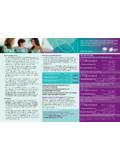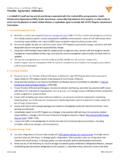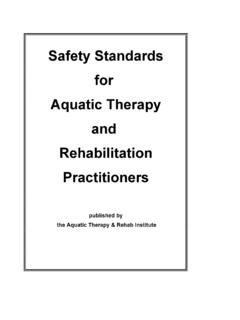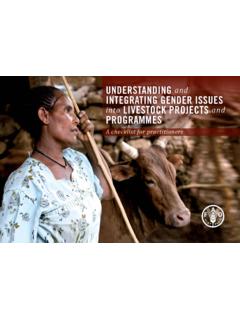Transcription of A Practitioner’s Guide - statsamerica.org
1 A practitioner s Guide To Economic Development Tools for Regional Competitiveness in a Knowledge-Based Economy This project was supported by a grant from the Economic Development Administration Research conducted by Center for Regional Development, Purdue University Indiana Business Research Center, Kelley School of Business, Indiana University Center for Regional Competitiveness, Rural Policy Research Institute, Truman School of Public Affairs, University of Missouri Strategic Development Group, Inc. Economic Modeling Specialists, Inc. practitioner s Guide 1 Table of Contents TABLE OF CONTENTS .. 1 INTRODUCTION .. 2 BENEFITS TO PRACTITIONERS .. 3 WHY FOCUS ON REGIONS AND INNOVATION? .. 5 USING THE TOOLS .. 6 Industry Cluster Analysis .. 6 Innovation Index .. 8 Occupation Clusters .. 10 Guidelines for Regional Investment Decisions .. 14 FOR FURTHER INFORMATION .. 17 practitioner s Guide 2 Introduction All of our economies community, regional, state, and national are undergoing fundamental changes.
2 That means that the job of the economic development practitioner is also shifting dramatically. To understand how to develop prosperity within their economies, economic development practitioners need new tools, new frameworks, and new practices. In every dimension, economic development has become more complex and challenging. We are moving from a relatively simple game of checkers to a sophisticated game of chess. These challenges create exciting, new opportunities. Entrepreneurs and high-growth companies are finding new ways to leverage the resources of our colleges and universities. New regional energy systems are emerging around renewable energy sources. Old-line manufacturers are coming together to explore new opportunities in emerging markets in health-care equipment, fresh water technologies, renewable energy, advanced materials, and advanced transportation. New agribusiness systems are emerging around regional foods and organic farming.
3 State and local policymakers are shifting their focus to entrepreneurs, innovation, collaboration, and new ways to support emerging, high-growth companies. To take advantage of these new opportunities, this practitioner s Guide introduces a new set of tools for the practitioner that leverage the power of the Internet. On one hand, t hey generate quick insights that can help the economic development practitioner find new opportunities. On the other hand the tools can assist both practitioners and community leaders in steering a course for long-term growth. The four tools are: Industry Cluster Analysis: With a useful set of 17 clusters, this tool helps the practitioner see networks of businesses that are creating wealth in their local or regional economy. This tool enables economic development professionals to define their own regions. As such, it represents a major advance in both the ease and flexibility of industry cluster analysis.
4 Regional Innovation Index: Businesses generate new wealth through innovation. Until now, economic development practitioners had no practical way to measure the innovation capacity of their local or regional economy. This innovation index represents a breakthrough in regional economic analysis. For the first time, professionals can examine the capacity of their economy to support innovative companies. Like the industry cluster tool, practitioners can design their own region by deciding which counties to include in their analysis. Occupational Cluster Analysis: One of the major transformations underway involves the closer integration of education, workforce development and economic development. For many economic development practitioners, this shift opens unfamiliar territory to their practice. The occupation cluster tool provides fast insights into the talent base that drives a local or regional economy. With this tool, economic development professionals can begin to structure effective collaborations with businesses managers, educators, and workforce development professionals.
5 Like the industry cluster practitioner s Guide 3 analysis and the regional innovation index, the occupation cluster analysis is flexible. It starts at the county level, but practitioners can assemble their own regions by grouping individual counties. Guidelines for Regional Organization and Investment Decisions: In the new world of economic development, collaboration matters, but it is often tricky. The guidelines for regional organization and investment decisions help leaders move forward as a region. These guiding principles provide frameworks for establishing investment priorities and making investment decisions. Unlike general guides on collaboration, these guidelines are designed specifically to meet the needs of economic development professionals who must structure investments among cooperating partners. This Guide will introduce each tool and give examples of how the tools might be used. The development team for these tools includes: The Purdue Center for Regional Development The Indiana Business Research Center Strategic Development Group, Inc.
6 The RUPRI Center for Regional Competitiveness Economic Modeling Specialists, Inc. Benefits to Practitioners For economic development professionals, regional planners, and community leaders, the four tools offer new ways to understand and strengthen their regional economy. Specifically, the four tools offer the following benefits. Industry Clusters Industry cluster analysis undertakes a sequence of steps to identify and locate the clusters present in a region s economy, as well as providing a way to gauge the clusters strengths and weaknesses compared to the national economy. Such insights can assist in maintaining or increasing cluster strengths by strategic resource targeting. Industry cluster analysis can also help identify new and emerging clusters to replace old and fading ones. Specifically, this tool allows practitioners to: Describe how industries in a region compare to each other. Identify growth trends through regional location-quotient analysis of industry clusters.
7 Reveal emerging industries in a region. Analyze the mix of clusters in a diverse region that might include both rural and urban areas. Apply a cluster matrix analysis to evaluate potential growth opportunities. Rethink business expansion strategies using cluster analysis. Reveal groups of industries that have similar workforce needs. Build sustained business-to -business connections. Prioritize groups of firms that have growth potential. Create regional identities and improve marketing effectiveness. practitioner s Guide 4 Innovation Index The innovation index provides some perspective on how well a regional economy translates knowledge and innovation capacity into prosperity. Innovation is a critical capability for regional economies, and this is the first practical tool that can assess how well any regional economy innovates. Specifically, this tool allows practitioners to: Understand how a region compares to the nation, other regions and states in terms of innovation capacity and innovation results.
8 Use online tools to test regional scenarios with different sets of county partners. Reveal the individual innovation index components of a region, for example, the occupational mix, level of educational attainment, high-tech industry employment, R&D investment, venture capital investment, and broadband density. Use the economic well-being sub-index to help communicate the need for new development. Occupation Clusters Occupation clusters offers insights into the knowledge, skills and abilities of the regional workforce that go beyond the relatively simple measure of educational attainment, such as highest degree earned. Specifically, this tool allows practitioners to: Analyze the regional knowledge-based workforce in greater detail. Combine industry and occupation cluster data to gain new insights into the regional economy. Understand the local workforce and educational situation within the broader regional economic development context.
9 Bridge the gap between workforce and economic development when constructing a regional economic development strategy. Use the local and regional occupation cluster mix to diagnose how well positioned the region and its communities are to participate effectively in a knowledge-based innovation economy. Determine how well occupation cluster strengths align with the region s industry cluster strengths. Regional Investment Decisions Guidelines for regional investment decisions offer useful frameworks for building a collaborative regional strategy and making strategic investment decisions. Specifically, this tool allows practitioners to: Align regional leaders in a common direction for development. Capitalize on fundamental elements for regional Improve the regional strategy process through coaching. Use data to help leaders reach consensus on investment decisions. 1 The five fundamental elements of regional development are: brainpower; innovation and entrepreneurship networks; quality, connected places; branding and storytelling; and collaborative leadership.
10 practitioner s Guide 5 Why Focus on Regions and Innovation? Regional Development These four tools have been crafted to assist local practitioners in implementing regional approaches to economic development. E conomic development professionals have long recognized that marketing an individual community is not the most effective means to long-term prosperity. T oday, this is increasingly true. Whether considering new basic employer recruitment or workforce development, a regional approach has significant advantages. In the arena of new business recruitment, it is easier to gain a site locator s attention by promoting a regional area. In a globalizing economy, site locators rarely restrict themselves to city or county boundaries. A sub-state or multi-state region is easier to market to prospects on the other side of the country or the world. The brainpower that fuels your economy is regional. Commuters daily ignore county boundaries to travel from home to their place of work outside of their communities.







